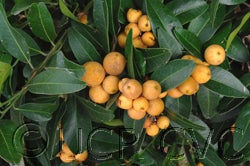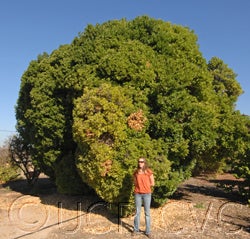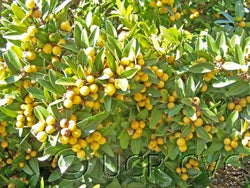Cochin China atalantia
CRC 1430
PI 539145
Source
Received as a cutting from W.T. Swingle, USDA (cutting A), 1924.
Parentage/origins
Parents unknown.
Rootstocks of accession
Cleopatra mandarin
Season of ripeness at Riverside
August to December
Season of flowering at Riverside
July to August
Notes and observations
WPB: This tree was girdled by frost near the groundline in 1949, saved by inarching with Morton citrange and trifoliate. Small yellow-green fruits-1/2" in diameter- 4 carpellate- seedless- occasional seed.
EMN, 12/22/1987: Nice appearing compact tree (small). No fruit now but bloom and flower buds are present.
EMN, 1/23/1989: Several small purple fruits found- similar to fruit of CRC 3287. Some fruits are green & purple.
Description from The Citrus Industry Vol. 1 (1967)
"Guillaumin's original description of this species reads, in translation, as follows: "Trees 5-10 m high, glabrous, spines straight, few, 5 mm long, in the axils of the leaves; branches grayish. Petioles glabrous, 1 cm long. Leaves coriaceous, ovate (5-9 X 2-4 cm), entire, attenuate at the base, attenuate and emarginate at the apex, primary and secondary veins prominent above and below, oil glands visible only by being pellucid [to transmitted light]. Flowers very glabrous, in the axils of the leaves, pedicels glabrous, 1 cm long, with bracts at the base; calyx cupulate, with 3 or 4 lobes, obtuse at the apex; petals 4, reflexed, ovate, attenuate at the apex; stamens 10, almost as long as the petals, more or less equal, connate for 2/3 of their length, anthers ovate, apiculate; disk annular at the base of the ovary; ovary ovoid-elongate, terminating in an articulated cylindric style, caducous at maturity, stigma capitate, locules 3-5, ovules 1-2 [in each locule], collateral. Fruit very similar to a small orange, 2 cm diam., pulp made up of succulent vesicles, seeds ellipsoid, about 1 cm long."
The specimens from Cambodia were said by Guillaumin to differ from those from Cochin China in having the young twigs, as well as the peduncles and pedicels of the flower clusters, slightly pubescent, as shown in his figure C, cited
This species has the filaments of the stamens united into a cylindrical tube like A. monophylla and A. racemosa. The tips of the filaments (about one-third of their length) are free and the anthers are oval and apiculate, not triangular, as in A. monophylla. The petals are narrowed at the tip, not broadly rounded. The inflorescences resemble those of A. monophylla, having rather long-pediceled flowers clustered on short inflorescences in the axils of the leaves. The calyx is much like that of A. racemosa, with three to four sepals. The fruits resemble small oranges about 20 mm in diameter, with a rough peel and the flesh formed of sessile, conical pulp-vesicles. The seeds are ellipsoid, about 10 mm long.
This species grows to be a medium-sized tree, 5 to 10 m high, and is probably larger and more vigorous than any other species of the subgenus Atalantia except A. macrophylla.
Although this species looks much like A. monophylla and has flowers with similar staminal tubes, it differs greatly in having a calyx with distinct sepals, unlike the curious balloon-like calyx of A. monophylla and A. macrophylla that splits irregularly into two or three lobes as the flower bud expands. Tanaka (1930a, p. 163) made this species a synonym of A. monophylla, overlooking this important difference. Guillaumin, who studied A. monophylla, also widely distributed in Indo-China, considered it to be clearly distinct from A. citroides."
Availability
Not commercially available in California.
USDA Germplasm Resources Information Network page for Atalantia citroides



